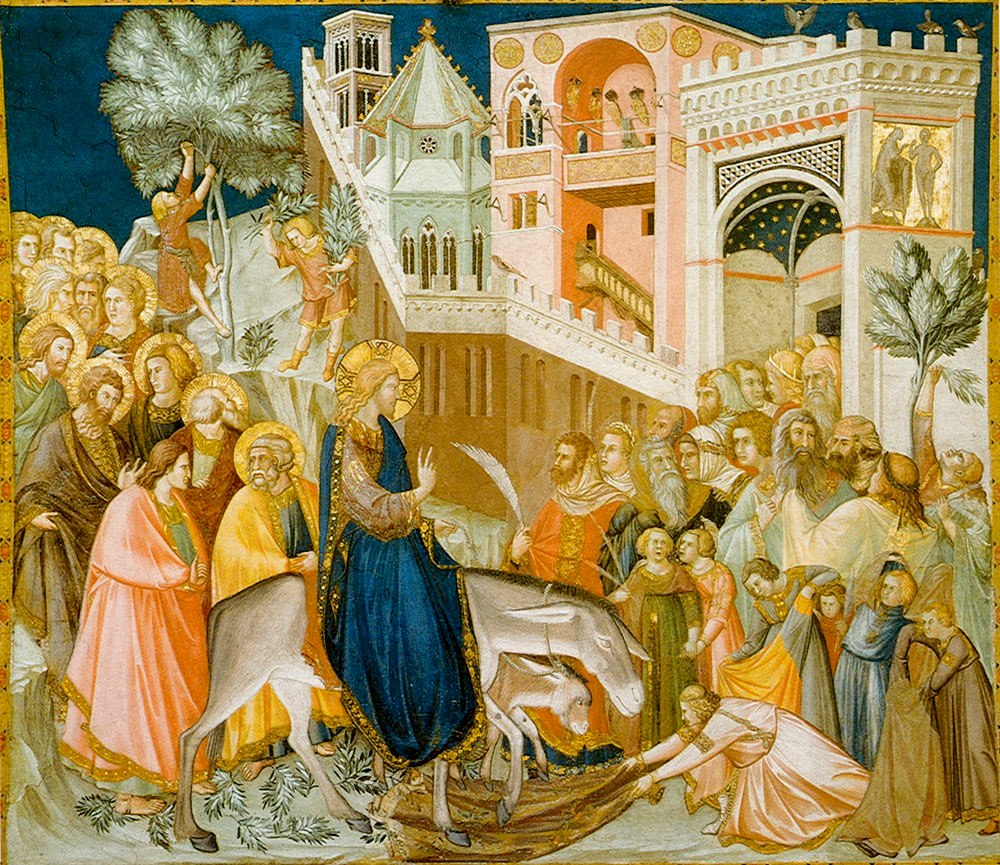Palm Sunday
What is Palm Sunday?

Palm Sunday is the day we celebrate the triumphal entry of Jesus into Jerusalem, one week before His resurrection (Matthew 21:1–11). As Jesus entered the holy city, He neared the culmination of a long journey toward Golgotha. He had come to save the lost (Luke 19:10), and now was the time—this was the place—to secure that salvation. Palm Sunday marked the start of what is often called “Passion Week,” the final seven days of Jesus’ earthly ministry. Palm Sunday was the “beginning of the end” of Jesus’ work on earth.
Palm Sunday began with Jesus and His disciples traveling over the Mount of Olives. The Lord sent two disciples ahead into the village of Bethphage to find an animal to ride. They found the unbroken colt of a donkey, just as Jesus had said they would (Luke 19:29–30). When they untied the colt, the owners began to question them. The disciples responded with the answer Jesus had provided: “The Lord needs it” (Luke 19:31–34). Amazingly, the owners were satisfied with that answer and let the disciples go. “They brought [the donkey] to Jesus, threw their cloaks on the colt and put Jesus on it” (Luke 19:35).
As Jesus ascended toward Jerusalem, a large multitude gathered around Him. This crowd understood that Jesus was the Messiah; what they did not understand was that it wasn’t time to set up the kingdom yet—although Jesus had tried to tell them so (Luke 19:11–12). The crowd’s actions along the road give rise to the name “Palm Sunday”: “A very large crowd spread their cloaks on the road, while others cut branches from the trees and spread them on the road” (Matthew 21:8). In strewing their cloaks on the road, the people were giving Jesus the royal treatment—King Jehu was given similar honor at his coronation (2 Kings 9:13). John records the detail that the branches they cut were from palm trees (John 12:13).
On that first Palm Sunday, the people also honored Jesus verbally: “The crowds that went ahead of him and those that followed shouted, ‘Hosanna to the Son of David!’ / ‘Blessed is he who comes in the name of the Lord!’ / ‘Hosanna in the highest heaven!’” (Matthew 21:9). In their praise of Jesus, the Jewish crowds were quoting Psalm 118:25–26, an acknowledged prophecy of the Christ. The allusion to a Messianic psalm drew resentment from the religious leaders present: “Some of the Pharisees in the crowd said to Jesus, ‘Teacher, rebuke your disciples!’” (Luke 19:39). However, Jesus saw no need to rebuke those who told the truth. He replied, “I tell you . . . if they keep quiet, the stones will cry out” (Luke 19:40).
Some 450 to 500 years prior to Jesus’ arrival in Jerusalem, the prophet Zechariah had prophesied the event we now call Palm Sunday: “Rejoice greatly, Daughter Zion! / Shout, Daughter Jerusalem! / See, your king comes to you, / righteous and victorious, / lowly and riding on a donkey, / on a colt, the foal of a donkey” (Zechariah 9:9). The prophecy was fulfilled in every particular, and it was indeed a time of rejoicing, as Jerusalem welcomed their King. Unfortunately, the celebration was not to last. The crowds looked for a Messiah who would rescue them politically and free them nationally, but Jesus had come to save them spiritually. First things first, and mankind’s primary need is spiritual, not political, cultural, or national salvation.
Even as the coatless multitudes waved the palm branches and shouted for joy, they missed the true reason for Jesus’ presence. They could neither see nor understand the cross. That’s why, “as [Jesus] approached Jerusalem and saw the city, he wept over it and said, ‘If you, even you, had only known on this day what would bring you peace—but now it is hidden from your eyes. The days will come upon you when your enemies . . . will not leave one stone on another, because you did not recognize the time of God’s coming to you” (Luke 19:41–47). It is a tragic thing to see the Savior but not recognize Him for who He is. The crowds who were crying out “Hosanna!” on Palm Sunday were crying out “Crucify Him!” later that week (Matthew 27:22–23).
There is coming a day when every knee will bow and every tongue confess that Jesus Christ is Lord (Philippians 2:10–11). The worship will be real then. Also, John records a scene in heaven that features the eternal celebration of the risen Lord: “There before me was a great multitude that no one could count, from every nation, tribe, people and language, standing before the throne and before the Lamb. They were wearing white robes and were holding palm branches in their hands” (Revelation 7:9, emphasis added). These palm-bearing saints will shout, “Salvation belongs to our God, who sits on the throne, and to the Lamb” (verse 10), and who can measure sum of their joy?
Palm Sunday Calendar 21st century:
2024 — March 24 (Western)
April 28 (Eastern)
2025 — April 13 (Western)
April 13 (Eastern)
2026 — March 29 (Western)
April 5 (Eastern)